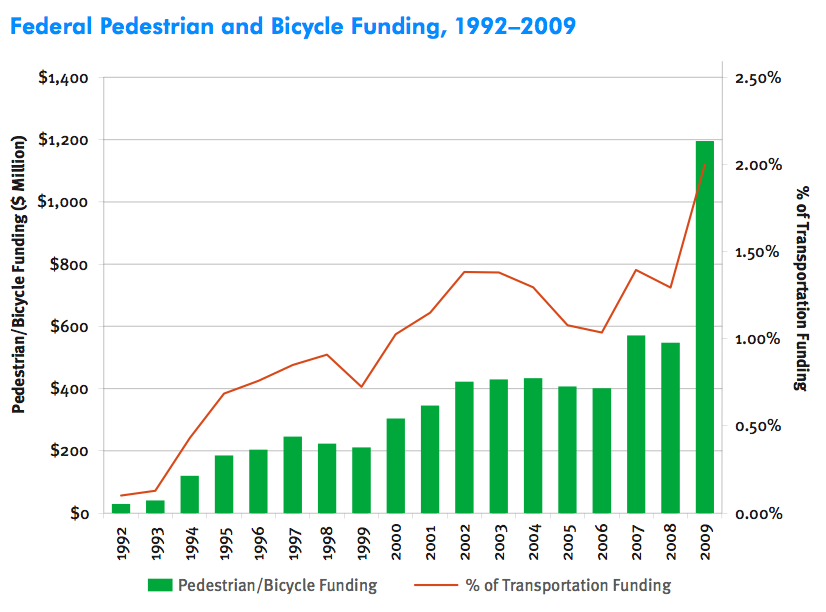U.S. DEPARTMENT OF TRANSPORTATION
PEDESTRIAN AND BICYCLE INFORMATION CENTER
Assessing National Trends in Bicycling and Walking
Since the publication of the National Bicycling and Walking Study, there has been measurable progress in improving conditions for bicycling and walking. Far from being “forgotten,” bicycling and walking have received a growing amount of attention and funding. There have also been decreases in fatalities, coupled with some evidence of an increase in the overall number of trips taken by bike or foot.
Funding
The National Bicycling and Walking Study was commissioned by Congress through the Department of Transportation and Related Agencies Appropriations Act in 1991. The Intermodal Surface Transportation Efficiency Act (ISTEA) of 1991 also authorized billions of dollars of transportation funds. These funds could be used for a range of transportation projects, including bicycling and walking improvements. Several programs were set up to supply this funding, including the following:
- Surface Transportation Program (STP), including Transportation Enhancement Activities and Highway Safety funds;
- Congestion Mitigation and Air Quality (CMAQ) Improvement Program;
- National Highway System funds; and
- Federal Lands Highway Program funds.
As a result of this legislation, Federal-aid spending on pedestrian and bicycle improvements increased from $6 million in 1990 to over $238 million in 1997. About three-fourths of this funding came from the Transportation Enhancements (TE) Activities (www.enhancements.org). In 1998, Congress passed the Transportation Equity Act for the 21st Century (TEA-21), a reauthorization of the ISTEA legislation. Covering the period of 1999 through 2004, TEA-21 brought about another increase in pedestrian and bicycle funding. Federal spending on these modes increased from $204 million in 1999 to over $427 million in 2004, with about two-thirds from TE Activities. The TEA-21 legislation also established sustained funding for the Recreational Trails Program, which provides funding to the States to develop and maintain recreational trails.
The next reauthorization of Federal transportation legislation came in 2005 with the Safe, Accountable, Flexible, Efficient Transportation Equity Act: A Legacy for Users (SAFETEA-LU). Intended to cover the period of 2005 to 2009, SAFETEA- LU again increased funding for pedestrian and bicycle program improvements. Though funding obligations declined slightly in its first year, obligations for fiscal year 2009 were nearly $1.2 billion. This sudden increase in funding was due in part to the 2009 American Recovery and Reinvestment Act (ARRA), which added more than $400 million in supplemental funds for bicycle and pedestrian projects and programs.4 (FY 2009 bicycle and pedestrian obligations would have reached an all-time high of $783 million without the ARRA funds. The TE Activities provided about 37 percent of the non-ARRA funds for pedestrian and bicycle projects, as increasingly larger shares have come from a wider variety of Federal-aid funding sources.)
SAFETEA-U also set up two new programs intended to support nonmotorized transportation: the Safe Routes to School Program and the Nonmotorized Transportation Pilot Program. Both programs sought to address growing needs within the bicycle and pedestrian communities and are covered later in this report.
Though the increase in funding between 1992 and 2009 has been substantial, pedestrian and bicycle obligations still account for only a small percentage of the overall Federal transportation budget. In 2009, about 2.0 percent of Federal-aid surface transportation funds were used for pedestrian and bicycle programs and projects. However, those two modes are estimated to account for almost 12 percent of all trips and represent more than 13 percent of all traffic fatalities.
Tags: Bicycling, Pedestrian, Pedestrian and Bicycle Information Center, U.S. Department of Transportation, US DOT, Walking







 RSS Feed
RSS Feed